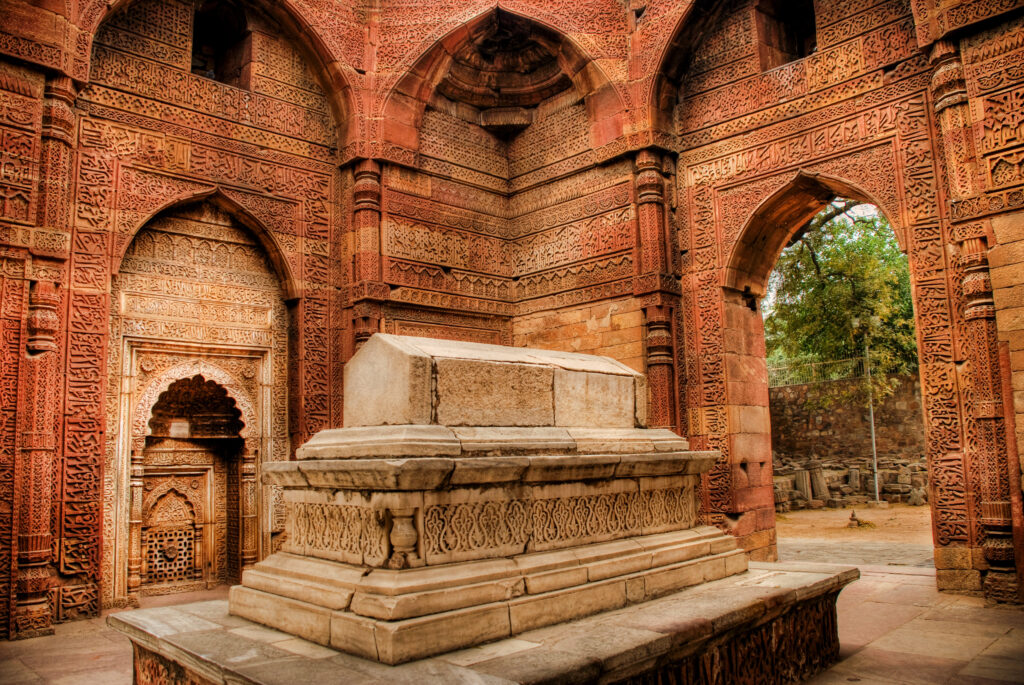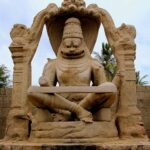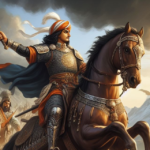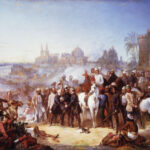The Slave Dynasty, also known as the Mamluk Dynasty, was a Muslim dynasty that ruled in India from 1206 to 1290. The dynasty was founded by Qutb-ud-din Aibak, who was a slave of the Ghurid ruler, Muhammad Ghori. The Slave Dynasty was the first Muslim dynasty to rule over India, and its rulers were of Turkish origin.
Qutub-din-Aibak
- Qutb-ud-din Aibak was the founder of the Slave Dynasty in India and the first Muslim ruler of India.
- He was a Turkic slave who rose through the ranks of Muhammad Ghori’s army.
- He conquered territories in northern India, including Delhi, Ajmer, and Ranthambore.
- He established the city of Qila Rai Pithora, which later became the capital of the Delhi Sultanate.
- He introduced administrative reforms, including the appointment of loyal governors and the establishment of a standing army.
- He is credited with introducing the Indo-Islamic architectural style, which blended elements of Islamic and Hindu architecture.
- He built the Qutub Minar in Delhi, which is a UNESCO World Heritage Site and one of the tallest minarets in the world.
- He died in 1210 after falling off his horse during a game of polo.
- He was succeeded by his son-in-law, Aram Shah, who was an unpopular ruler and was quickly overthrown.
- Qutb-ud-din Aibak is remembered as a key figure in the early Muslim conquests of India and the founder of the Delhi Sultanate.

Iltutmish (1211-1236)
Iltutmish (1211-1236) was the third ruler of the Slave Dynasty in India. He was the son-in-law of Qutb-ud-din Aibak and is considered one of the greatest sultans of the Delhi Sultanate. Here are some important points about him for SSC CGL:
- Accession to the throne: Iltutmish came to power after a power struggle within the Slave Dynasty following the assassination of his predecessor, Aram Shah.
- Administrative reforms: Iltutmish is credited with introducing several administrative reforms, including the division of the empire into provinces called Iqtas, the appointment of competent officials as governors, and the establishment of a central secretariat to manage the affairs of the empire.
- Military campaigns: Iltutmish undertook several successful military campaigns during his reign, including the conquest of Bengal, Bihar, and parts of modern-day Uttar Pradesh.
- Patronage of arts and architecture: Iltutmish was a patron of arts and architecture, and he commissioned the construction of several buildings in the Indo-Islamic architectural style, including the Qutub Minar, the Alai Darwaza, and the tomb of Imam Zamin.
- Diplomatic relations: Iltutmish maintained diplomatic relations with other rulers and dynasties, including the Khwarazmian Empire, the Abbasid Caliphate, and the Mongol Empire.
- Succession: Iltutmish established a system of succession based on merit, rather than inheritance, and he nominated his daughter, Razia Sultana, as his successor.
- Death: Iltutmish died in 1236, and he was succeeded by Razia Sultana, who became the first and only female ruler of the Delhi Sultanate.
Razia Sultana

- Razia Sultana was born in 1205 to Sultan Iltutmish and his wife, Turkan Khatun.
- She was well-educated and fluent in several languages, including Persian, Arabic, and Turkish.
- Razia Sultana was appointed as the governor of several provinces, including Bhatinda and Mewat, which helped her gain valuable administrative experience.
- She was a patron of the arts and literature, and supported the work of poets and writers during her reign.
- Razia Sultana introduced several measures to improve the lives of her subjects, including providing food and shelter to the poor and promoting trade and commerce.
- She was known for her military skills and led several campaigns against rebels and insurgents.
- Razia Sultana faced opposition from her male relatives, who did not accept her as the rightful ruler of the empire.
- She married Altunia, the governor of Bhatinda, who helped her fight against her enemies and rebels.
- Razia Sultana’s reign came to an end when she was betrayed by her own troops, who were bribed by her opponents.
- Despite her tragic end, Razia Sultana remains a symbol of female empowerment and a role model for women who aspire to break gender barriers and achieve success in their chosen fields.
Balban

- Balban was a prominent noble and military commander in the court of Sultan Iltutmish, and later became the Sultan himself, ruling from 1266 to 1287.
- He was born in the region of Central Asia and belonged to a Turkish tribe.
- Balban was known for his military prowess and strategic skills, and he led several successful campaigns against the Mongols and other enemies of the Delhi Sultanate.
- He introduced several administrative reforms, including creating a powerful bureaucracy, strengthening the position of the Sultan, and implementing a strict code of conduct for officials and nobles.
- Balban was known for his harsh treatment of rebels and opponents, and he established a network of spies and informers to root out dissent and maintain law and order.
- He also took steps to improve the economy and infrastructure of the empire, including building several new forts, canals, and roads.
- Balban was a patron of the arts and literature, and supported the work of poets and scholars during his reign.
- He faced several rebellions and uprisings during his reign, including one led by his own nephew, but he was able to suppress them all.
- Balban was succeeded by his grandson, who was deposed after a short reign, leading to a period of instability and conflict in the Delhi Sultanate.
- Despite his reputation for being ruthless and authoritarian, Balban is remembered as a capable and efficient ruler who played a significant role in the history of the Delhi Sultanate.
Muiz-ud-din Qaiqabad
- Muiz-ud-din Qaiqabad was the son and successor of Nasiruddin Mahmud, who was himself the son and successor of Balban.
- He came to the throne at the age of 17, following the sudden death of his father.
- During his short reign, Muiz-ud-din Qaiqabad faced several challenges, including rebellions by his own nobles and the Mongol invasion of India.
- He tried to maintain the policies of his grandfather Balban, including the strict enforcement of law and order and the promotion of Persian culture and language.
- Muiz-ud-din Qaiqabad was known for his generosity and patronage of the arts, and he supported the work of poets and scholars during his reign.
Downfall of Slave Dynasty
The Slave Dynasty, which ruled the Delhi Sultanate from 1206 to 1290, faced various challenges including weak successors, rebellions by powerful nobles, Mongol invasions, economic problems, factionalism among the ruling class, and a loss of central authority. All these factors contributed to its downfall and paved the way for the emergence of new ruling dynasties in India.
Recommended Reading
- The Vijayanagara Empire (1336–1646)
- Akbar the Great (1542-1605)
- The Khilji Dynasty: A Powerful Era of Turbulence and Transformation 1290-1320
- The Great Maurya Dynasty (322 BCE – 184 BCE)
MCQ on Slave Dynasty for SSC CGL
- Who was the founder of the Slave Dynasty in India?
a) Balban
b) Iltutmish
c) Qutb-ud-din Aibak
d) Razia Sultana
Answer: c) Qutb-ud-din Aibak - The Slave Dynasty in India ruled from:
a) 1192 to 1206
b) 1206 to 1290
c) 1290 to 1320
d) 1320 to 1414
Answer: b) 1206 to 1290 - Qutb-ud-din Aibak was originally a slave of:
a) Muhammad Ghori
b) Alauddin Khilji
c) Iltutmish
d) Razia Sultana
Answer: a) Muhammad Ghori - Who among the following rulers of the Slave Dynasty built the Qutub Minar?
a) Balban
b) Iltutmish
c) Qutb-ud-din Aibak
d) Razia Sultana
Answer: b) Iltutmish - Who was the first Muslim ruler to introduce the silver tanka and copper jital as currency in India?
a) Balban
b) Iltutmish
c) Qutb-ud-din Aibak
d) Razia Sultana
Answer: b) Iltutmish - The famous Persian poet Amir Khusrau was associated with which ruler of the Slave Dynasty?
a) Balban
b) Iltutmish
c) Qutb-ud-din Aibak
d) Razia Sultana
Answer: b) Iltutmish - Who among the following rulers of the Slave Dynasty was known for his policy of blood and iron?
a) Balban
b) Iltutmish
c) Qutb-ud-din Aibak
d) Razia Sultana
Answer: a) Balban - The Slave Dynasty was overthrown by which dynasty?
a) Khilji Dynasty
b) Tughlaq Dynasty
c) Sayyid Dynasty
d) Lodhi Dynasty
Answer: a) Khilji Dynasty - Which ruler of the Slave Dynasty was known as the ‘Silver King’?
a) Balban
b) Iltutmish
c) Qutb-ud-din Aibak
d) Razia Sultana
Answer: d) Razia Sultana - Razia Sultana was the first and only female ruler of the Slave Dynasty. True or False?
Answer: True - The Slave Dynasty was of Turkish origin. True or False?
Answer: True - Who among the following rulers of the Slave Dynasty was known as the ‘Parrot of India’?
a) Balban
b) Iltutmish
c) Qutb-ud-din Aibak
d) Razia Sultana
Answer: d) Razia Sultana - Which ruler of the Slave Dynasty was known for his efficient spy system?
a) Balban
b) Iltutmish
c) Qutb-ud-din Aibak
d) Razia Sultana Answer: a) Balban
- The Slave Dynasty was the first Muslim dynasty to rule Delhi. True or False?
Answer: True - Who succeeded Qutb-ud-din Aibak as the ruler of the Slave Dynasty?
a) Balban
b) Iltutmish
c) Razia Sultana
d) Nasiruddin Mahmud
Answer: b) Iltutmish - Which ruler of the Slave Dynasty introduced the ‘Chahalgani’ system?
a) Balban
b) Iltutmish
c) Qutb-ud-din Aibak
d) Razia Sultana
Answer: a) Balban - The Slave Dynasty was established after the defeat of the Rajput ruler:
a) Prithviraj Chauhan
b) Rana Sanga
c) Raja Jaichand
d) Raja Bhoj
Answer: a) Prithviraj Chauhan - Who among the following rulers of the Slave Dynasty was known for his religious tolerance?
a) Balban
b) Iltutmish
c) Qutb-ud-din Aibak
d) Razia Sultana
Answer: b) Iltutmish - Which ruler of the Slave Dynasty was the first to establish the Delhi Sultanate?
a) Balban
b) Iltutmish
c) Qutb-ud-din Aibak
d) Razia Sultana
Answer: c) Qutb-ud-din Aibak - The Slave Dynasty was known for its architectural achievements, especially in the construction of mosques. True or False?
Answer: True - Which ruler of the Slave Dynasty introduced the ‘iqta’ system?
a) Balban
b) Iltutmish
c) Qutb-ud-din Aibak
d) Razia Sultana
Answer: b) Iltutmish - The Slave Dynasty faced several Mongol invasions during its rule. True or False?
Answer: True - Who among the following rulers of the Slave Dynasty was assassinated by his own nobles?
a) Balban
b) Iltutmish
c) Qutb-ud-din Aibak
d) Razia Sultana
Answer: d) Razia Sultana - The capital city of the Slave Dynasty was:
a) Agra
b) Lahore
c) Delhi
d) Jaunpur
Answer: c) Delhi - The Slave Dynasty played a significant role in the establishment of the Delhi Sultanate and laid the foundation for the subsequent Muslim rule in India. True or False?
Answer: True









